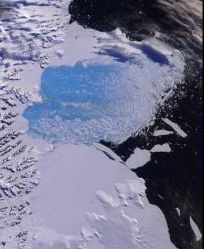 > ENC Master > Climate Encyclopaedia > Oceans > more > 1. Oceans and climate > - Sea level rise
> ENC Master > Climate Encyclopaedia > Oceans > more > 1. Oceans and climate > - Sea level rise
 |
|
|
|
The OceansRead More |
Sea level riseChanges in sea level have occurred throughout the history of the Earth. During the most recent ice age, sea level was much lower than it is now because so much of the water was frozen and stored on land. At the moment our sea level is rising and the main culprit is global warming.
|
|
Sea levels vary either because the amount of water in the oceans changes or the land moves. Because it takes a long time for the Earth to adjust to changes in the weight of ice and water on it, land movements today are often the result of processes which occurred many thousands of years ago. Changes to the amount of water held in the oceans can happen faster. What processes affect sea level and how much is the sea rising?Geological data shows that, over the last 6000 years, sea level has risen on average between 0.5 and 1.0 mm every year. The extend of the sea level rise varies with the location, because the land can be falling or rising in response to ice loss at the end of the last ice age. Generally, however, the expansion of the warming water and input from melting ice caused an average sea level rise. Over the 3000 years, sea level has risen slower, averaging 0.1 to 0.2 mm per year. During the 20th Century, the rate of sea level rise has increased again and is now about 10 times faster than this, between 1.0 and 2.0 mm every year. For every centimetre the sea rises, around one metre of coastal land is lost to the sea. Although most people think sea level rise is just due to the melting of ice on land, the most important factor is simply that the density of water decreases as it gets warmer. This leads to an increase in the water volume, a process known as thermal expansion. As the oceans are like basins, a rise in sea level is the only way the oceans can cope with the increase in volume.
|
 |
|
1. Rising temperatures decrease the density of seawater. This leads to an increase in its volume. As the oceans are like basins, a rise in sea level is the only way the oceans can adjust to this change in volume. The end result is flooding. Author: Lucinda Spokes. |
|
Melting of ice on land is the second most important part of sea level rise (melting of floating icebergs doesn't affect sea level, an example of Archimedes' Principle). If all the ice sheets in Antarctica and Greenland melted, sea level would rise by 70 metres! This means that small changes in their volume can have big effects on sea level. Even the much smaller ice caps and glaciers on the rest of the Earth contain enough water to raise sea level by half a metre. Archimedes' Principle says "An object totally or partially immersed in water is lifted up by a force which is equal to the weight of water it displaces".
|
Although the big ice sheets on Antarctica contain huge amounts of water, we don't think they have actually contributed much to sea level rise over the last century. Even with global warming, its still not warm enough in summer for much of the ice to melt. Global warming seems rather to make it snow more, cause more ice to form and sea level to fall here. Thre have been lots of studies on the Western Antarctic Ice Sheet as this, on its own, contains enough water to raise sea level by six metres. Recently large bits of the floating Larsen Ice Sheet have broken off. Our worries are than this will make the big ice sheets actually on Antarctica less stable, allowing them to slip into the sea and cause huge rises in sea level. Summer temperatures in Greenland are warm enough to allow parts of the ice caps here to melt so this region is likely to contribute more than Antarctica to sea level rise.
|
|
|
Changing the amount of water we store on land in resevoirs and in groundwater is also likely to alter sea level but at the moment we're not sure how much. Computer models predict that sea level will continue to rise in the next century. There are still huge uncertainties mostly because we don't have enough long term data from around the world to test our models. However, the best predictions are that sea level will rise between 11 and 77 centimetres by the end of the 21st Century. Although there are great variations in these estimates, all the studies show that the rise in sea level will not be the same all over the world.
|
What are the consequences of sea level rise?For every centimetre the sea rises, about one metre of land is lost to the sea. The consequences of this are huge.
About this page:author: Lucinda Spokes - Environmental Sciences, University of East Anglia, Norwich - U.K.
|

